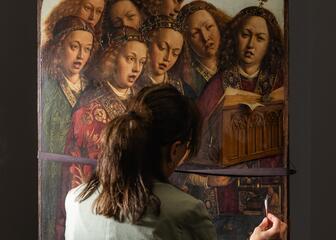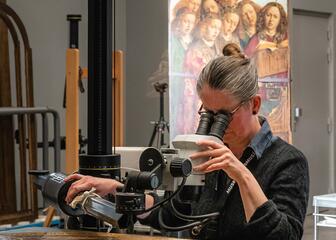

When the first phase of the conservation, the work on the exterior shutters, was being carried out, I was not yet involved in the conservation. I do remember though that it was a big surprise for the experts to see how much had been overpainted. In the centuries following Van Eyck, layer after layer had been added. Sometimes, this was in order to repair damage, on occasions to refresh the colours and at other times to reflect contemporary tastes. Eventually, large parts of the original had been completely covered over.

That was certainly quite an eye-opener. When you realise that there is already an entire library of publications about Van Eyck's technique, it was sobering to see the extent to which his hand was missing from The Ghent Altarpiece.... Of the outer panels, as much as two-thirds had been overpainted! Not recently, but as long ago as the sixteenth century. As far as the inner panels were concerned, things were not so bad, but even so, almost half of the central panel with the lamb had also been reworked. We are still working on the conservation of the uppermost panels, but a large number of old overpaintings can be found there as well.
Flemish primitives under the scanner
The reason our understanding has grown so much is due in part to cutting-edge technology. The MA-XRF, or to give it its full name the Macro X-ray Fluorescence Scan, played an important role in this. By working with the University of Antwerp, we can use that method to chart all chemical elements across the entire surface of the panels. This provides information about the chemical composition of the paint layers, the presence of overpainting, any damage in the underlying layers and so on.

Nowadays, MA-XRF has become a standard feature of the conservation project, but in 2012 it was still a novelty. It was certainly very exciting. When using methods like those, you actually felt a bit like the detective putting the pieces of the puzzle together. By the way, the entire conservation process is well documented on the Closer to Van Eyck website. There, you can zoom in on the smallest detail and compare how it appeared before, during and after conservation, including the infrared and X-radiographs..
Layer upon layer upon layer
The goal of our conservation was – and still is – to remove everything that we are 100% sure is not original. This must also be something that can be done completely safely, without causing any damage to the original. Of course, we would like to come as close as possible to how The Ghent Altarpiece appeared when Jan Van Eyck finished working on it in 1432. On a practical level, this mainly involves removing the overpaints from the 16th century and later.
Of course, we as conservators do not make those decisions alone. Once a month, we meet with the stakeholders, and several times a year with a Belgian advisory committee of art historians and conservators. We discuss and document the process in detail. The most important decisions are only made after receiving additional advice from 22 international experts. I'll spare you the details, but we're certainly never going to leave anything to chance.
Learn more about the restoration process of the Ghent Altarpiece
Zoom in on the smallest detail and compare how it appeared before, during and after restoration, including on the infrared and X-ray images.
Not everything used to be better
Look, every generation that retouched or updated The Ghent Altarpiece did so with the best of intentions and that is just as true for us. The profession has evolved considerably during the past century and has now become an interdisciplinary science. In the past, everything had to be done with the naked eye, but we now have stereo microscopes that enable us to recognise overpaintings by their texture or see where age cracks have been covered over.
Thanks to scientific imaging such as infrared reflectography, radiography and Ma-XRF, we can get an even more detailed picture of the paint layers and the underlying damage. And then there is the chemical analysis of microscopic paint samples. For example, if we detect ground soda glass (a sodium-rich glass) or posnjakite (a particular green pigment), we are certain that the paint is 16th-century. Van Eyck never used those particular materials.
I see Van Eyck's brushwork, his technique, and sometimes I can even see the individual grains of pigment in the paint. As a conservator, I can then connect with the moment when the masterpiece was first created.
The hand of the painter
Another important difference: we work reversibly. When we repair and retouch damage, we do so with paints and varnishes that will stand the test of time, but are easy to remove again.

This may all sound very technical, but it is actually a magical process. You get to experience how the work comes to life. Soon, for example, we will have to fill in a small loss near Adam's nipple. If we didn't do that, that smallwhite spot would attract too much attention. By filling a small loss, you sometimes see a brushstroke reappear. Suddenly, you get to feel what Van Eyck himself intended and that is certainly a fantastic experience.
Back to the future: six centuries of history
I have only come to appreciate Van Eyck more. I remember working on the panel with the hermits. When I removed the discoloured layers of varnish from a hat, I noticed a thin white accent on the side, no thicker than a strand of hair, which Van Eyck used to give extra volume to the hat. What a genius! Even on a zoomed-in photo, it is never as impressive as when you look at it yourself at such close range. It's those tiny revelations that really stick in your mind.

I see Van Eyck's brushwork, his technique, and sometimes I can even see the individual grains of pigment in the paint. As a conservator, I can then connect with the moment when the masterpiece was first created. At the same time, I can already see the marks of history: cracks and damage and areas where the paint has come off. And then I see time and evolution. So on the one hand, I'm looking at a single moment, but on the other hand, I can see six centuries of history right before me. That feels like a very privileged situation to be in.
Kathleen Froyen
The conservator Kathleen Froyen has been working full-time on The Ghent Altarpiece since 2018. She coordinates the conservation studio at the Museum of Fine Arts and sits on many steering committees and advisory committees, but most of all, she enjoys getting behind the microscope herself to do some real work: the conservation of Van Eyck's magnum opus.












